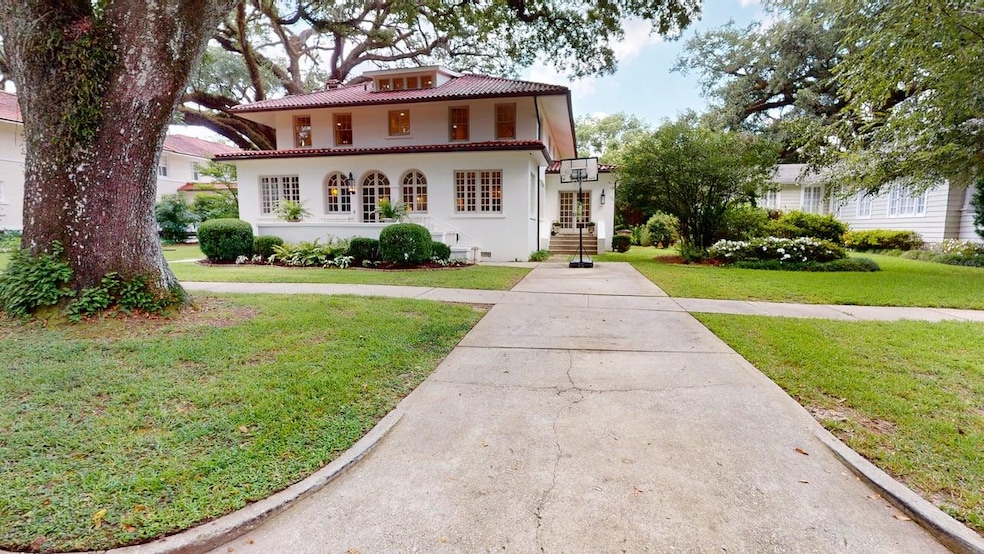Lanier Avenue in Mobile, Alabama, is a short street bordered by live oaks that can live to be hundreds of years old.
Almost certainly, at least some of these evergreens already had hard bark on them in 1909 when Charles Sims, president of the American Realty Co., built the house at 211 Lanier Ave. A sapling compared to the trees that surround it, the 116-year-old home hit the market in August for $1.57 million.
Melissa Morrissette of LLB&B Inc. Real Estate is handling the listing.

“The view of the majestic live oaks that line our street is a serene way to start the day,” owner Sarah Stashak said.
'We had nothing that looked like that'
The 3,673-square-foot, two-story home is swirling with the history of Mobile’s turn of the last century "boom time," according to local historian Cartledge Blackwell, curator of the Mobile Carnival Museum.
“If you think about that time period, it was one of Mobile’s golden ages,” Blackwell said. Mobile’s port was the country’s preeminent access to the markets of Cuba and South America, and the city had become a train hub to much of the metropolitan U.S.

Empowered by new wealth, the city had an explosion of Colonial Revival architecture to connect to its history. It is one of the only U.S. cities to have once been ruled by the French, British and Spanish.
Spain captured the city in 1780 during the American Revolution and held it until U.S. forces took control of it in 1813. In honor of this period, builders in the 19th and 20th centuries incorporated Spanish Colonial architecture, such as the house Sims built.
“Of course, we had nothing that looked like that,” Blackwell said. “But it tied into the rage for Spanish Colonial that you find in Florida and California.”
Blackwell attributes the home to architect Clarence Hutchisson, who built 17 other documented homes in the city. “There’s no blueprints that survive, but it resembles other buildings that he did in that neighborhood,” Blackwell said.

Neighborhood is historic, too
The home is located in the Ashland Place Historic District. The neighborhood was named after Ashland, the home of author Augusta Evans Wilson, who wrote “St. Elmo” and was the first writer of any gender in America to earn more than $100,000. Unfortunately, Wilson’s house burned down in the 1920s.
“Ashland Place is the most beautiful and well-known of the city’s turn-of-the-century subdivisions,” Blackwell said.
Developed by pioneering suburban developer George Fern, Ashland was Mobile’s first City Beautiful subdivision, an architectural and planning philosophy that sought to beautify the utilitarian aspects of civic life.
“City Beautiful subdivisions had gracious lawns,” Blackwell said. “There were stipulations on the size of houses, where you located buildings like garages or servants’ quarters.”
The result was a more varied style of housing than one might expect. “Nothing is cookie-cutter here!” Stashak said. “This is a truly multigenerational neighborhood with young families, empty nesters and older couples.”

Fern also worked with the city’s streetcar company to help with site selection for his neighborhoods to ensure they offered easy mobility. “When they knew where streetcars were going in, they would buy properties,” Blackwell said.
Home is preserved but updated
Stashak said she and her husband were attracted to the home’s history. “Mike and I have always had a love for the charm of older homes, but we like certain modern touches,” she said.
The home received a restoration and upgrade from its previous owners, from whom the Stashaks bought the house in 2016 for $929,000, according to county records. Stainless steel appliances, a Sub-Zero fridge and marble countertops were added to the kitchen, among other changes.
The Stashaks made some improvements as well, adding a detached garage with a roughly 500-square-foot studio apartment above it.

But the four-bedroom, 4.5-bathroom main house has retained its original wood and tile floors, its fireplace in the living room and its missionary-style back porch that also includes a fireplace.
“Our back porch is one of the most beautiful features of the house, with room for dining, relaxing by the fireplace and enjoying the mature landscaping of the back yard,” Stashak said.
The home has survived hurricanes, economic downturns and pandemics.
“We’ve done our best to honor the history of the home but update it for our fun-loving family,” Stashak said.
